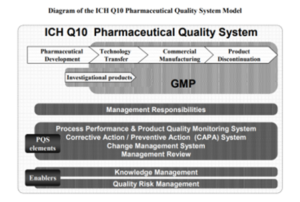Clinical Researcher—June 2023 (Volume 37, Issue 3)
MANAGEMENT & MEASUREMENT
Michelle Anastasi
Change management is integral to ensuring appropriate implementation and maintenance practices for pharmaceutical quality systems (PQS).
Effective change management systems ensure that innovation and continual improvement are facilitated, that change is appropriate and proportionate, and that key personnel take a level of ownership of the change. Processes related to change management must include an understanding of the current state and a vision for the future state.
Change (Mis)management
The challenge, however, is that people and organizations both resist and embrace change, and far too frequently the process fails to deliver against the required objectives. How change is communicated and managed will play a pivotal role in determining whether success or failure is the dominating outcome for a business.
An International Framework for Pharmaceutical Quality Systems
The International Council for Harmonization of Technical Requirements for Registration of Pharmaceuticals for Human Use (ICH) guideline Q10 describes a comprehensive framework for a PQS. The ICH Q10 system does not add requirements beyond existing regulatory compliances; rather it standardizes the framework to that of the International Organization for Standardization (ISO) and works with regional Good Manufacturing Practice (GMP) regulations. This standardization ensures global alignment—ultimately saving significant time and any potential reworking when expanding the geographic reach of a product.

The ICH Q10 and the U.S. Food and Drug Administration (FDA) guidance that supports its implementation assists companies to find a standardized approach and adopt a more comprehensive and holistic way of evaluating the risk that any change might pose.
The process should be defined and documented, and all key functional areas and personnel identified. A structured framework such as the ICH Q10 ensures consistent assessments without gaps are used to inform decisions and to evaluate change. For example, a manufacturing process change can be evaluated using the same structure as a label change. Although some aspects and details will not be applicable to all stages and scenarios, the overarching process of the assessment and moving through the decision-making should be structured in the same way.
Working Through the Change Management Process
Having a well-structured change management system, including procedures that detail how and when to proceed and how to evaluate change, is critical to ensuring that the quality and commercial viability of the product is not compromised.
In the current state, for example where a manufacturing process is already under way, there are likely to be specific details contained in the marketing authorization. An evaluation of the current state and the future state will involve detailing and prioritizing all the elements that must be modified, or may be optional but desirable, to get to the future state. Often companies start to get a little tripped up in that process, because there are a lot of complexities within that change state. Functional heads can lose sight of the broader impact, for example, on how a change might impact whether the product can be distributed in another market.
Having a defined process for working through change and going through an assessment process of which functional heads need to be involved in thinking through the change, how that affects other processes, and how that change should be documented is key to good change management. Again, the ICH Q10 assists the process of working across different areas of expertise and within varying jurisdictions and countries by ensuring the documented process and requirements are developed in a standardized, accessible way and in a known sequence. It is clear to all personnel what the requirements are in managing and documenting changes and the filings that are required for the various marketing authorities.
During manufacturing, for example, change management would consider a change in the context of the impact to the facility where the equipment is used, the validated state of both the equipment and the process, the impact to testing, the impact to all documentation involved (such as test methods, forms, batch records, calibration, maintenance forms and plans, and regulatory filing) and would detail a plan for implementation considering each of these changes and the relative timeline and dependencies of changes in the critical path.
Inclusion of Stakeholders
Consultation with key personnel early in the change process, with a genuine invitation for their input, is integral to their ongoing engagement and the ultimate success of the process overall. The identified stakeholders will generally be from, at a minimum, technical operations and engineering, regulatory affairs, and quality assurance (QA), and must fully evaluate the proposal from their functional point of view. For example, regulatory affairs should always evaluate the impacts on regulatory filings, while QA should evaluate all changes and oversee the entire change management process.
This would include the identification of the systems, processes, and documents that would most likely be impacted by the proposed change. They may also be able to flag any concerns and they would have knowledge that the proposer of the change may lack. They should approve any changes before starting the change process and have the power to modify or reject the change.
Many companies employ a Change Control Review Board to consider these impact assessments and ensure each department is considering the change from all perspectives.
The Change Control Review Board is a set of individuals, functionally specific to the change. QA and regulatory affairs would typically be standing members to ensure an overarching perspective and ongoing compliance with regulatory requirements, respectively. Smaller businesses may not need an entire formal Change Control Review Board, but they must ensure they have oversight of any changes, particularly when outsourcing manufacturing, and of the resulting effect on quality and regulatory requirements.
Quality Risk Management and the Marketing Authorization
Integral to any change management process is the inclusion of quality risk management. The ICH Q10 assists companies to evaluate risk with a standardized approach. The evaluation and understanding of risks apply to each individual component, each functional area, and the overall process and product. This is, in theory, straightforward, but may rapidly become complex in execution, so a defined structure for managing and evaluating changes is essential.
The marketing authorization includes details of production, incorporating location, manufacture, testing, packaging, logistics, and distribution of the product. Modifications to any of these requires a detailed evaluation of the change and the impact, or potential impact, of that change on product quality and patient safety.
For example, if there is an increased risk of failure to supply to meet patient demand, the risk is proportional to the product. A single-manufacturer, life-saving medication carries a much higher patient risk than a generic, multi-producer headache tablet.
Key Steps for Evaluating Change Objectives
Any change management process should encompass an evaluation process to ensure objectives were met. Having an effectiveness check with relevant metrics provides an understanding of the business benefit of the implemented change, as well as any positive impact on the quality and safety of the product.
A simple example might be a manufacturing change to increase product yield. The introduction of a larger machine may double the apparent number of tablets produced for each hour worked, but downtime for maintenance may increase. The assessment would need to consider whether, over a predetermined timeframe, the new machine genuinely increased productivity or, once all factors were taken into account, there was a non-significant improvement or even a decline. Did the cost of the change justify the expense? The objective for the change must be fully assessed against the initial proposal for change and costs at all levels should be determined to provide a complete economic analysis.
Inside the Business to the Global Marketplace
Good change management involves a detailed procedure, detailed documentation, and open functional discussions that allow a company to assess the impact of the change on a technical and business level.
The ICH Q10 structure enables internal clarity of management and assessment processes for change, plus greater standardization to support access to international markets via a known framework that supports heavily regulated processes.

Michelle Anastasi is Director of Quality Management & Compliance in the U.S. for PharmaLex, where she serves as the international service lead for GxP Quality Management Systems, including eQMS/eDMS. She has more than 20 years of industry experience in quality management and GMP.



